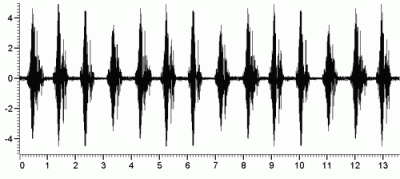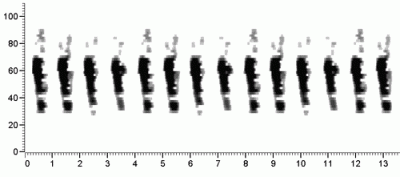A widespread species, found from east coast to west coast and from central Canada into northern Mexico. Shown below are fourteen SRUs, each consisting of a single volley of abdominal vibration, which an insect typically produces repetitively. In a duet, the partner would insert his or her SRU between the SRUs illustrated; the partners match their tempo to one another.
This is the species in which vibrational communication was first demonstrated — i.e., see Henry, C. S. 1979, Acoustical communication during courtship and mating in the green lacewing Chrysopa carnea (Neuroptera: Chrysopidae). Ann. Entomol. Soc. Am. 72: 68-79 (back then, plorabunda was thought to be part of C. carnea Stephens, and the nameChrysoperla was not commonly used).
For more up-to-date information, see Henry, C. S., M. M. Wells, and R. J. Pupedis. 1993. Hidden taxonomic diversity within Chrysoperla plorabunda (Neuroptera: Chrysopidae): two new species based on courtship songs. Ann. Entomol. Soc. Am. 86(1): 1-13.
A study of the extraordinary dueting capabilities in the species can be found in Henry CS, Wells MLM. 2006. Testing the ability of males and females to respond to altered songs in the dueting green lacewing, Chrysoperla plorabunda (Neuroptera: Chrysopidae). Behavioral Ecology and Sociobiology 61: 39-51.

